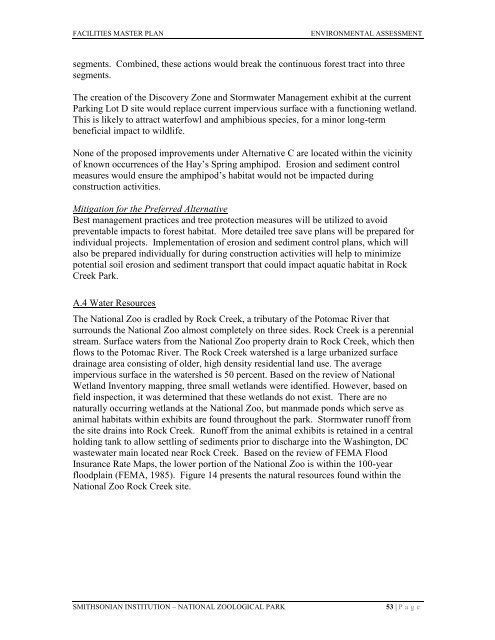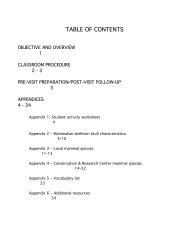facilities renewal master plan - National Zoo - Smithsonian Institution
facilities renewal master plan - National Zoo - Smithsonian Institution
facilities renewal master plan - National Zoo - Smithsonian Institution
You also want an ePaper? Increase the reach of your titles
YUMPU automatically turns print PDFs into web optimized ePapers that Google loves.
FACILITIES MASTER PLAN ENVIRONMENTAL ASSESSMENT<br />
segments. Combined, these actions would break the continuous forest tract into three<br />
segments.<br />
The creation of the Discovery Zone and Stormwater Management exhibit at the current<br />
Parking Lot D site would replace current impervious surface with a functioning wetland.<br />
This is likely to attract waterfowl and amphibious species, for a minor long-term<br />
beneficial impact to wildlife.<br />
None of the proposed improvements under Alternative C are located within the vicinity<br />
of known occurrences of the Hay’s Spring amphipod. Erosion and sediment control<br />
measures would ensure the amphipod’s habitat would not be impacted during<br />
construction activities.<br />
Mitigation for the Preferred Alternative<br />
Best management practices and tree protection measures will be utilized to avoid<br />
preventable impacts to forest habitat. More detailed tree save <strong>plan</strong>s will be prepared for<br />
individual projects. Implementation of erosion and sediment control <strong>plan</strong>s, which will<br />
also be prepared individually for during construction activities will help to minimize<br />
potential soil erosion and sediment transport that could impact aquatic habitat in Rock<br />
Creek Park.<br />
A.4 Water Resources<br />
The <strong>National</strong> <strong>Zoo</strong> is cradled by Rock Creek, a tributary of the Potomac River that<br />
surrounds the <strong>National</strong> <strong>Zoo</strong> almost completely on three sides. Rock Creek is a perennial<br />
stream. Surface waters from the <strong>National</strong> <strong>Zoo</strong> property drain to Rock Creek, which then<br />
flows to the Potomac River. The Rock Creek watershed is a large urbanized surface<br />
drainage area consisting of older, high density residential land use. The average<br />
impervious surface in the watershed is 50 percent. Based on the review of <strong>National</strong><br />
Wetland Inventory mapping, three small wetlands were identified. However, based on<br />
field inspection, it was determined that these wetlands do not exist. There are no<br />
naturally occurring wetlands at the <strong>National</strong> <strong>Zoo</strong>, but manmade ponds which serve as<br />
animal habitats within exhibits are found throughout the park. Stormwater runoff from<br />
the site drains into Rock Creek. Runoff from the animal exhibits is retained in a central<br />
holding tank to allow settling of sediments prior to discharge into the Washington, DC<br />
wastewater main located near Rock Creek. Based on the review of FEMA Flood<br />
Insurance Rate Maps, the lower portion of the <strong>National</strong> <strong>Zoo</strong> is within the 100-year<br />
floodplain (FEMA, 1985). Figure 14 presents the natural resources found within the<br />
<strong>National</strong> <strong>Zoo</strong> Rock Creek site.<br />
SMITHSONIAN INSTITUTION – NATIONAL ZOOLOGICAL PARK 53 | P a g e

















